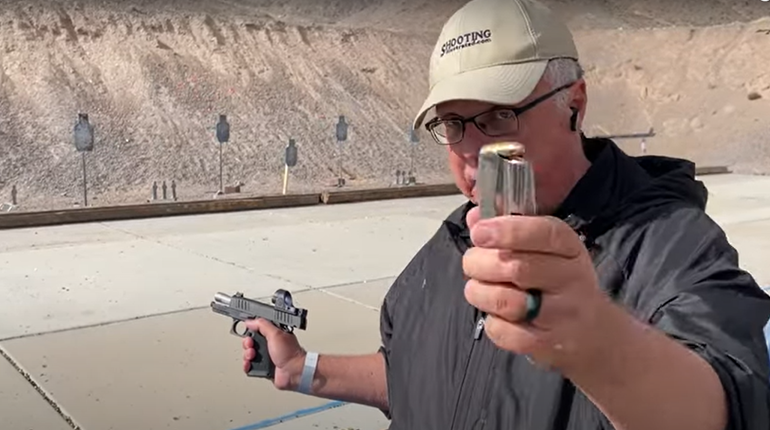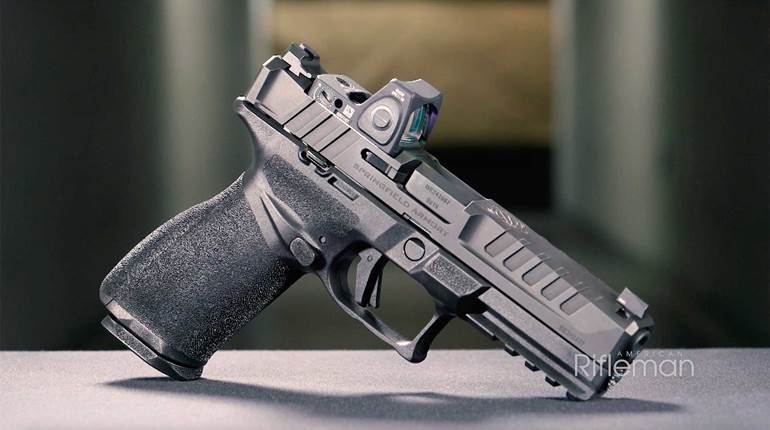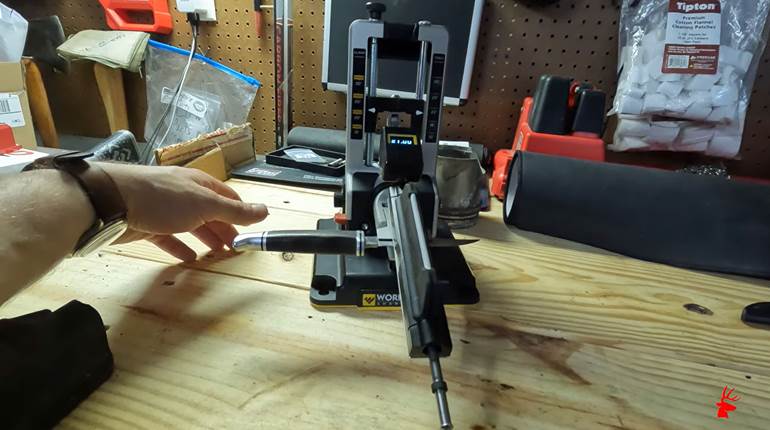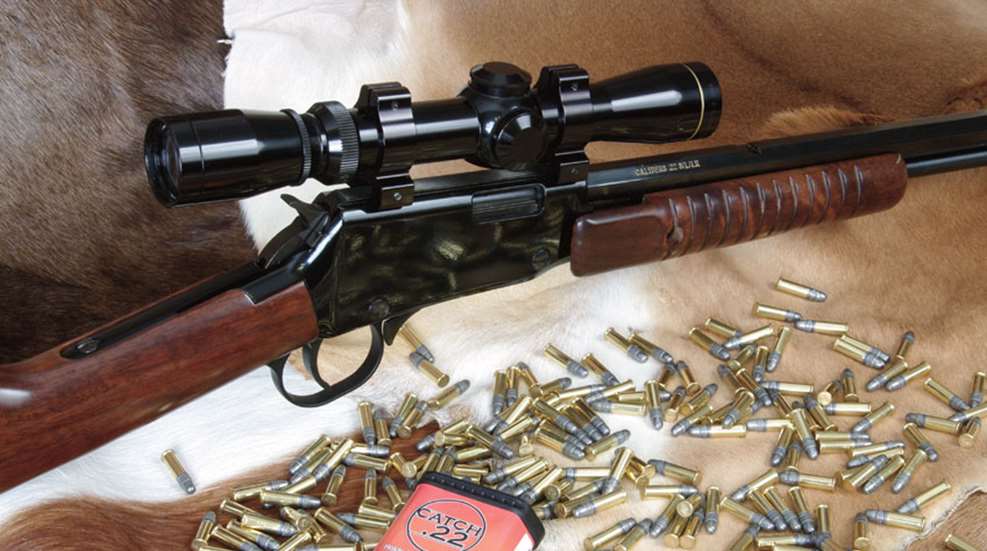
The pump-action .22 rifle has a long tradition in America, and the Henry Repeating Arms Co. is big on tradition. With a few notable exceptions, the majority of its rifles are modern versions of traditional lever-actions. So it makes sense the company would resurrect the American pump-action .22-cal. rifle.
The Henry Pump-Action Octagon, now made in New Jersey, is a nice-looking rifle with an American walnut stock and fore-end. The octagonal, 19 3/4-inch-long barrel and other steel parts are polished blue. The rifle features Henry's zinc alloy receiver cover, which is finished in black, but within this cover are steel action parts. A single operating bar links the fore-end to an internal action lever that locks and unlocks the bolt as the fore-end is worked. As the action closes, a spring-loaded locking bar rises into a corresponding notch in the bottom of the bolt to effect lock-up. On retracting the fore-end to open the bolt, dual opposed hook extractors keep the cartridge case tight against the bolt face until the rim hits the fixed ejector to throw the case free of the gun.

Capable of chambering .22 Short, .22 Long and .22 Long Rifle ammunition, the Pump-Action Octagon is fed by a tubular magazine located under the barrel. Its capacity is 15 rounds of .22 Long Rifle or 21 .22 Shorts. Loading is through a port in the tube's underside cut in the shape of a cartridge. Turning out the knurled knob at the end of the tube allows the brass inner magazine tube and follower to be retracted, readying the gun for loading.
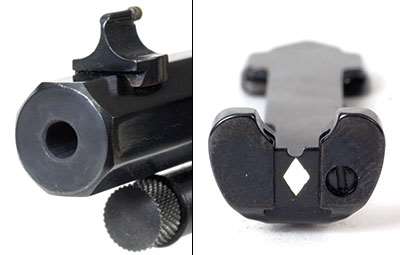
The gun comes with a brass bead front sight, and its semi-buckhorn style rear sight is adjustable for elevation using a stepped elevator wedge and for windage by drifting it in the dovetail. There are 3/8-inch dovetails on the barrel's top for both the front and rear sights, and this standard-size dovetail allows changing to aftermarket sights. The receiver has a slightly raised rail on top that is grooved for a tip-off-style scope mount. Also, the front support band for the magazine tube is fitted into a dovetail on the bottom of the barrel.
The walnut stock on the sample rifle exhibited some figure in the grain, particularly in the fore-end, which is a pleasant and unexpected surprise on a gun at this price. The wood-to-metal fit was excellent, and the gloss finish on the wood flawless. There was no checkering, but the fore-end had a dozen grooves cut into each side to aid in gripping. Topping the butt was a hard plastic buttplate with the Henry logo molded into it.
There is no manual safety, but the external hammer, powered by a coil spring, has a half-cock safety position, and the hammer must be manually cocked or the action cycled to fire the rifle the first time. Each time the action is subsequently worked, the hammer stays back in the full-cock position. When the hammer is down or in the half-cock position the action is unlocked and may be opened, but in the full-cock position the action is locked. There is a release lever on the right side in front of the trigger guard that unlocks the action and allows it to open with the hammer at full cock.
The action was initially slightly stiff, but very smooth, indicating tight-fitting parts and that attention was paid to the mating surfaces on moving parts. Also, the 1.35 inches of movement provides a short throw to cycle the action but a loss of leverage, which makes the action feel a bit stiffer. We actually found this action to be very fast and positive during rapid shooting drills on a dueling tree target, and the slight stiffness was not an impediment to operating the gun or to rapid shooting in any way. It should also be noted that after several hundred rounds the action was broken-in and became smoother and easier to work.
The rather long single-stage trigger pull was a bit rough and creepy with several identifiable hitches along the way. Nonetheless, it broke at 3 pounds, 2 ounces, which is good for a current factory trigger on a .22 rifle.
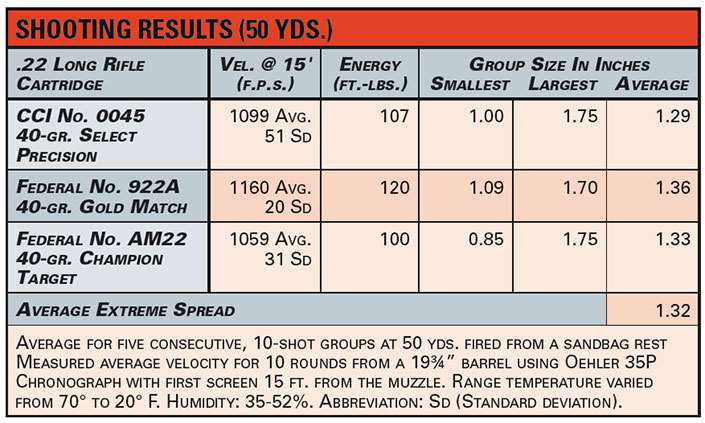
During several hundred rounds of function testing, we fired a variety of .22 CB (CCI), .22 Short, .22 Long and .22 CB Long (CCI) cartridges as well as several different .22 Long Rifle loads, including some hyper-velocity loads with a longer case. The gun functioned flawlessly, and all loads fed through the action with zero failures or malfunctions. Even when the magazine was filled with mixed cartridges from different manufacturers, the Henry would feed and function perfectly.
We did experience some difficulty with certain brands of ammunition while inserting the inner magazine tube into the full outer tube. The edge of the tube would catch on the cartridges, requiring that the tube be manipulated up and down in short strokes to allow the cartridges to enter. This was solved quickly by using a cartridge case deburring tool to add a slight bevel to the leading edge of the inner magazine tube.
The rifle was fitted with a Leupold 2-7X 28 mm rimfire scope for accuracy testing. The shooting was through several days and during a variety of weather conditions. Again, we experienced no problems. In the end the rifle proved to be very accurate for a small-game hunting or plinking rifle, as the results in the accompanying table indicate. Despite the few criticisms about the trigger and magazine tube, this is a well-made rifle with excellent function and accuracy at an especially attractive price.
Manufacturer: Henry Repeating Arms Co.; (201) 858-4400; www.henryrepeating.com
Caliber: .22 Short, .22 Long & .22 Long Rifle (tested); also available in .22 WMR
Action: pump-action rimfire rifle
Receiver: zinc alloy
Barrel length: 19¾"
Rifling: eight-groove, 1:16" RH twist (.22 LR); 1:9" .22 WMR
Magazine: tubular, 15-round capacity (Long Rifle)
Sights: brass bead front; fully adjustable semi-buckhorn rear; receiver grooved for tip-off style-mount
Trigger Pull: 3 lbs., 2 ozs.
Stock: American walnut; length of pull, 13 1⁄2"; drop at heel, 21⁄4"; drop at comb, 1 5⁄8 "
Overall length: 38 1⁄2"
Weight: 6 lbs.
Accessories: owner's manual
Suggested retail price: $500















